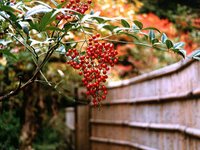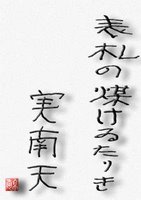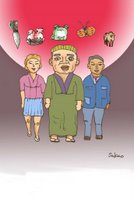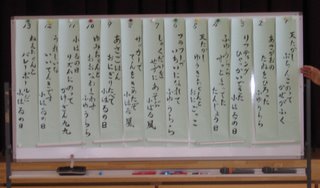[ . BACK to WORLDKIGO . TOP . ]
:::::::::::::::::::::::::::::::::::::::::::::::::::::::::::::::::::::::::::::::::::::::::::::::::::::
Missing Children's Day (international)
***** Location: Worldwide
***** Season: Early Summer (May 25)
***** Category: Observance
*****************************
Explanation
Since 1983, families and child advocates nationwide have observed
National Missing Children’s Day on May 25.
Proclaimed first by President Ronald Reagan and honored by every administration since, May 25 is the day 6-year-old Etan Patz disappeared from a New York City street corner on his way to school in 1979. His case remains unsolved and is an annual reminder to the nation to renew efforts to reunite missing children with their families and make child protection a national priority.
One reason Etan Patz’s case quickly received the attention of local and national news media -- even before cases of missing children routinely garnered such attention -- is that his father is a professional photographer, and Etan’s black-and-white portraits were quickly disseminated in an effort to find him. His case is a reminder to all parents of the need for high-quality pictures of their children, for use in case of an emergency, and for the need for everyone to pay close attention to the posters and pictures of missing children that in the 1990s have become a commonplace tool to help in the search for missing children.
... make sure that you keep current, high-quality pictures of your own children, regardless of their ages, and update them at least annually. A recent poll of law enforcement found that they consider pictures to be the single most important tool in the search for missing children.
Read the full text here please:
http://www.missingkids.com/missingkids/servlet/NewsEventServlet?LanguageCountry=en_US&PageId=1305
xxxxxxxxxxxxxxxxxxxxxxxxxxxxx
Mr Franco Frattini, Vice-President of the European Commission, today sent each member of the Commission staff a letter, together with a small cloth forget-me-not flower, which we shall be wearing tomorrow (25 May 2005), in memory of the world's missing children.
I was not previously aware of International Missing Children's Day, but the letter explains it well :
25 May -- forget-me-nots to commemorate missing children
> -------------------------------------------------------
Dear colleagues,
>
> You have all been sent a small artificial flower -- a forget-me-not -- through the post.
>
> On 25 May, 14 European countries will mark International Missing Children's Day. The date has been commemorated in the United States since 1983, when a six-year-old boy disappeared without trace. It has also been marked in Canada since 1986. The commemoration in Europe
was organised for the first time in 2002 on the initiative of Child Focus, the European Centre for Missing and Sexually Exploited Children. The forget-me-not has been chosen as a symbol for this event because of its name and because it flowers abundantly at this time of year.
>
> The main aim of International Missing Children's Day is to encourage people to remember all the children who have disappeared in Europe and the rest of the world and to send an international message of hope and solidarity to parents who have no information about the fate and whereabouts of their children.
>
> All over Belgium numerous volunteers will be distributing small pin-on forget-me-nots free to the public in supermarkets and shopping centres and to staff in private companies, hospitals, police stations and so on. This year International Missing Children's Day will be organised in Germany, Belgium, Bulgaria, Finland, France, Greece, Hungary, Italy, the Netherlands, Poland, Portugal, the Czech Republic, Romania and the United Kingdom.
>
> As a token of solidarity, may I suggest that Commission staff wear this symbol on 25 May 2005.
>
> The idea is also to think about the prevention strategies we can promote and adopt in close co-operation with the public authorities responsible for education, social policy and law and order.
>
> Thank you for your solidarity.
>
> (Signed) Franco Frattini
>

> -------
Belgium, host country to the European Commission, has some particularly horrific stories to remember... and brave children who only a few months back testified in court to the dreadful deeds which they suffered at cruel hands...
... but we also remember all other parents worldwide, searching for their children, and remember children far from their parents against their will, as well as parents and children who will never see each other again...
Web sites with more information, including that of Child Focus itself :
http://www.childfocus.org/
http://www.childfocus.be/fr/activities_3.php#2
http://washingtontimes.com/national/20040523-120656-2424r.htm
Forget them not, forget not the children, their parents and families,
Isabelle Prondzynski.
*****************************
Worldwide use
Germany
Tag der vermissten Kinder.
Gesuchte Kinder in Deutschland
http://www.gesuchte-kinder.de/
Die Kinderkommission des Bundestages erklärt zum Tag der vermissten Kinder am 25. Mai 2003
Immer wieder verschwinden in Deutschland Kinder. Ihr Aufenthaltsort ist z. T. über Jahre unbekannt. Hierzu gehören nicht nur Jugendliche, die von zu Hause „ausreißen“ und deren Verbleib nicht mehr festgestellt werden kann, sondern auch Kinder, die von einem Elternteil entzogen und z. T. ins Ausland verbracht werden, ohne dass der Aufenthalt bekannt wird. Schließlich gibt es Kinder, die verschwinden, ohne dass es Hinweise auf mögliche Ursachen und Aufenthaltsorte gibt.
Das plötzliche Verschwinden bedeutet nicht nur für Eltern, deren Kinder von jetzt auf gleich nicht mehr da sind, eine schwere Belastung. Auch für Kinder, die gewaltsam aus ihrem Umfeld entfernt werden, ist der plötzliche Entzug der gewohnten Umgebung und der Abbruch der Beziehungen zu beiden Elternoder einem Elternteil ein gravierender Einschnitt in ihrem Leben.
Die Kinderkommission begrüßt, dass es Initiativen gibt, die diese Kinder suchen und nicht aufgeben, ihren Aufenthaltsort zu ermitteln. So stellt z. B. die Internetseite www.vermisste-kinder.de Informationen über vermisste Kinder, Anlaufstellen, die beim Suchen helfen und auch über wieder aufgetauchte Kinder zur Verfügung.
„Wir dürfen die vermissten Kinder nicht aufgeben“, erklärt die Vorsitzende der Kinderkommission, Marlene Rupprecht
http://www.fredi.org/allemand/Ueber_die_Stiftung/unsre_Aktionen/25.Mai/vermisste_kinder_nicht_vergessen.htm
Verzeichnis der vermissten Kinder
:::::::::::::::::::::::::::::::::::::::::::::::::::::::::::::::::::::::::::::::::::::::::::::::::::::::::::::::::
Japan
the story of Anju and Zushi Oomaru 安寿と厨子王
Anju and Zusio
Once upon a time,
Anju and Zusio were sent to Tango (Kyoto), and their mother to Sado by swindler. On their way, Anju and Zusio managed to escape from him, but their mother was forced to work all days and finally she lost her eye sight.
Read the story here:
. Anju and Zushi Oomaru 安寿と厨子王 .
*****************************
Things found on the way

On 21 May 1997, the statue named "
Messenger to the Missing Children" by the Belgian artist
Jean Pierre Folon, was inaugurated in the Royal Park of Brussels in the presence of the Belgian sovereigns.
Belgium has had its own problems with abducted, violated and murdered children, and the statue gives encouragement to all who have suffered. It is a favourite place for those who want to remember lost children, and is itself often surrounded by children, as a puppet
theatres play in this part of the park during summer months.
© Photo and Text : Isabelle Prondzynski
*****************************
HAIKU
cruel deeds --
forget-me-not day...
bring peace... oh child...
Isabelle Prondzynski
:::::::::::::::::::::::::::::::::::::::::::::::::::::::::::::::::::::::::::::::::::::::::::::::::::::
carrying her placard
she leaves her children alone
forget-me-not
Brenda Roberts
xxxxxxxxxxxxxxxxxxxxxxxxxxxxx
falling star
a mother's emptiness
overflows

Laryalee Fraser
:::::::::::::::::::::::::::::::::::::::::::::::::::::::::::::::::::::::::::::::::::::::::::::::::::::::::::::::::
missing children -
toys they used to play with
hang on
Carlos Fleitas
:::::::::::::::::::::::::::::::::::::::::::::::::::::::::::::::::::::::::::::::::::::::::::::::::::::::::::::::::
Missing Children's Day
even I haven't found
myself yet
Ella Wagemakers
WKD on facebook, 2013
*****************************
Related words
. . Kigo Calendar - the 12 Months - MAY . .
[ . BACK to DARUMA MUSEUM TOP . ]
[ . BACK to WORLDKIGO . TOP . ]
:::::::::::::::::::::::::::::::::::::::::::::::::::::::::::::::::::::::::::::::::::::::::::::::::::::





























